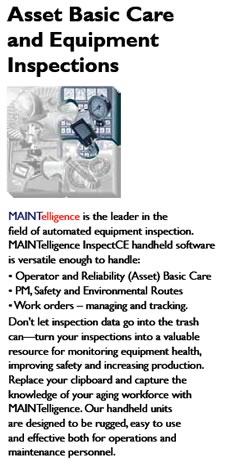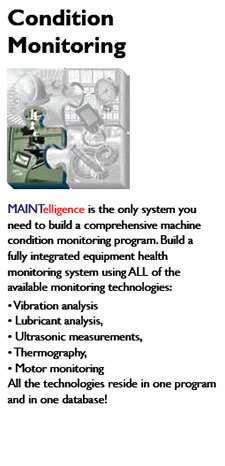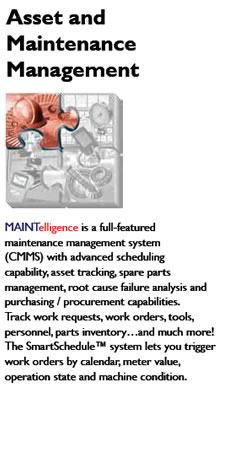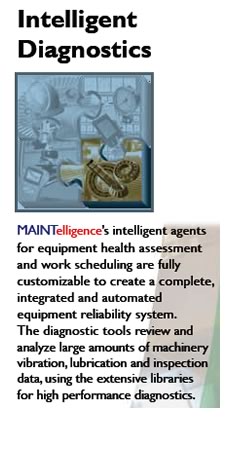 |
 |
||||||||
 |
|||||||||
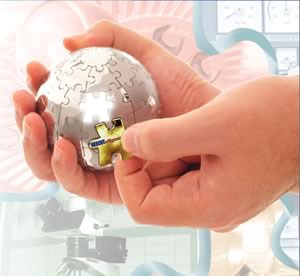 There is a good chance this product could make your life
easier by creating a highly organized framework and schedule
for basic equipment inspections, condition based maintenance,
and both maintenance and asset management. We
tracked down (and we do mean tracked, because he was on
vacation at the time) Steve Reilly, vice president of Design
Maintenance Systems, Inc., to discuss a pretty unique piece
of software called MAINTelligence. Steve is a well-known
innovator in the reliability and condition monitoring industry
who has designed and developed systems for vibration analysis,
lube oil analysis, maintenance management systems and
operations inspection. There is a good chance this product could make your life
easier by creating a highly organized framework and schedule
for basic equipment inspections, condition based maintenance,
and both maintenance and asset management. We
tracked down (and we do mean tracked, because he was on
vacation at the time) Steve Reilly, vice president of Design
Maintenance Systems, Inc., to discuss a pretty unique piece
of software called MAINTelligence. Steve is a well-known
innovator in the reliability and condition monitoring industry
who has designed and developed systems for vibration analysis,
lube oil analysis, maintenance management systems and
operations inspection.
Can you give us a brief overview of the MAINTelligence is used in hundreds of sites worldwide, ranging from single ships to some of the world’s largest industrial operations. It is used to manage Asset Basic Care programs (operator-based reliability initiatives), predictive maintenance programs and as a CMMS system. There are several modules available within MAINTelligence. Could
you explain each one briefly? In the last five years, the asset basic care module has generated the most interest because it seems to generate the greatest reliability gains in the shortest time. This module directly interfaces with Windows Mobile™ handheld devices (MAINTelligence InspectCE) for operator inspection and lubrication management. The latest innovation adds further integration to the asset basic care and predictive maintenance areas, an interface from our MAINTelligence InspectCE handheld to a digital output accelerometer. This allows operators to collect time waveform and spectral vibration data while conducting their inspections. In designing MAINTelligence, my primary objective was to create a framework that incorporated the CMMS aspects, (collecting costs and allocating resources). However, our customers made it apparent that there was demand for more focus on the management of predictive and inspection based maintenance data, along with standard corrective and preventive maintenance work orders. Thus, MAINTelligence differs in that it provides both CMMS and integrated asset reliability functions. Many times the data in a CMMS can be collected
but not acted upon. How does The major problem with predictive maintenance (PdM) programs is that data is collected, but recommendations for proactive maintenance never get turned into actual work orders. By integrating both asset basic care and predic- tive maintenance findings directly into the maintenance task schedule, work from PdM procedures is automatically generated, just like time or meter-based PM tasks. This allows maintenance planners to handle all tasks the same way, no matter what their origin. The significance of this is that maintenance schedules can automatically change based on the inspected or measured condition of the asset. And it doesn’t have to just be MAINTelligence as the CMMS – we have interfaces to many other ERP and EAM systems that allow us to trigger work orders automatically. What types of industries are currently using
MAINTelligence? A refinery in Memphis, TN, has reported the following results usingMAINTelligence: MTBF for rotating equipment improved from 42 months to 53 months, reduced unplanned maintenance from 80% total maintenance expense to 15% total maintenance expense, KPI on pumps has improved 61% and a documented savings of $1 million dollars in maintenance cost/year. At a pulp and paper mill in Louisiana in early 2004, after overcoming some initial resistance, both MAINTelligence-based asset basic care and a predictive maintenance program were implemented. Mechanics’ inspections generate approximately 300 corrective work orders per year that have improved the overall stability of the manufacturing process. By June 2005, the integrated reliability program was credited with a 20% ($30 per ton) reduction in maintenance costs. This happened at time when paper mills had been shutting down due to high operating costs and oversupply. Plant personnel achieved the cost reductions by embracing the integrated reliability concept and the culture of selfdiscipline that it implied. What size of an operation does
it take to justify purchasing
MAINTelligence? |
|
Vibration Monitoring | Infrared Imaging |MAINTelligence | Accelerometers | Laser Alignment | Ultrasonic Detection | Training | Accessories J L Griffin LLC. ~ E-mail jim@jlgriffin.com ~ 4625-B Turtle Creek Drive, Brookfield, WI 53005 ~ TEL 414.218.8088 |
 What sets
What sets 